Mengxing Huang
Graph Attention-based Reinforcement Learning for Trajectory Design and Resource Assignment in Multi-UAV Assisted Communication
Jan 31, 2024Abstract:In the multiple unmanned aerial vehicle (UAV)- assisted downlink communication, it is challenging for UAV base stations (UAV BSs) to realize trajectory design and resource assignment in unknown environments. The cooperation and competition between UAV BSs in the communication network leads to a Markov game problem. Multi-agent reinforcement learning is a significant solution for the above decision-making. However, there are still many common issues, such as the instability of the system and low utilization of historical data, that limit its application. In this paper, a novel graph-attention multi-agent trust region (GA-MATR) reinforcement learning framework is proposed to solve the multi-UAV assisted communication problem. Graph recurrent network is introduced to process and analyze complex topology of the communication network, so as to extract useful information and patterns from observational information. The attention mechanism provides additional weighting for conveyed information, so that the critic network can accurately evaluate the value of behavior for UAV BSs. This provides more reliable feedback signals and helps the actor network update the strategy more effectively. Ablation simulations indicate that the proposed approach attains improved convergence over the baselines. UAV BSs learn the optimal communication strategies to achieve their maximum cumulative rewards. Additionally, multi-agent trust region method with monotonic convergence provides an estimated Nash equilibrium for the multi-UAV assisted communication Markov game.
Three Efficient Beamforming Methods for Hybrid IRS-aided AF Relay Wireless Networks
Jan 07, 2023Abstract:In this paper, a hybrid IRS-aided amplify-and-forward (AF) relay wireless network is considered, where an optimization problem is formulated to maximize signal-to-noise ratio (SNR) by jointly optimizing the beamforming matrix at AF relay and the reflecting coefficient matrices at IRS subject to the constraints of transmit power budgets at the source/AF relay/hybrid IRS and that of unit-modulus for passive IRS phase shifts. To achieve high rate performance and extend the coverage range, a high-performance method based on semidefinite relaxation and fractional programming (HP-SDR-FP) algorithm is presented. Due to its extremely high complexity, a low-complexity method based on successive convex approximation and FP (LC-SCA-FP) algorithm is put forward. To further reduce the complexity, a lower-complexity method based on whitening filter, general power iterative and generalized Rayleigh-Ritz (WF-GPI-GRR) is proposed, where different from the above two methods, it is assumed that the amplifying coefficient of each active IRS element is equal, and the corresponding analytical solution of the amplifying coefficient can be obtained according to the transmit powers at AF relay and hybrid IRS. Simulation results show that the proposed three methods can greatly improve the rate performance compared to the existing networks, such as the passive IRS-aided AF relay and only AF relay network. In particular, a 50.0% rate gain over the existing networks is approximately achieved in the high power budget region of hybrid IRS. Moreover, it is verified that the proposed three efficient beamforming methods have an increasing order in rate performance: WF-GPI-GRR, LC-SCA-FP and HP-SDR-FP.
CMT: Interpretable Model for Rapid Recognition Pneumonia from Chest X-Ray Images by Fusing Low Complexity Multilevel Attention Mechanism
Oct 29, 2022



Abstract:Chest imaging plays an essential role in diagnosing and predicting patients with COVID-19 with evidence of worsening respiratory status. Many deep learning-based diagnostic models for pneumonia have been developed to enable computer-aided diagnosis. However, the long training and inference time make them inflexible. In addition, the lack of interpretability reduces their credibility in clinical medical practice. This paper presents CMT, a model with interpretability and rapid recognition of pneumonia, especially COVID-19 positive. Multiple convolutional layers in CMT are first used to extract features in CXR images, and then Transformer is applied to calculate the possibility of each symptom. To improve the model's generalization performance and to address the problem of sparse medical image data, we propose Feature Fusion Augmentation (FFA), a plug-and-play method for image augmentation. It fuses the features of the two images to varying degrees to produce a new image that does not deviate from the original distribution. Furthermore, to reduce the computational complexity and accelerate the convergence, we propose Multilevel Multi-Head Self-Attention (MMSA), which computes attention on different levels to establish the relationship between global and local features. It significantly improves the model performance while substantially reducing its training and inference time. Experimental results on the largest COVID-19 dataset show the proposed CMT has state-of-the-art performance. The effectiveness of FFA and MMSA is demonstrated in the ablation experiments. In addition, the weights and feature activation maps of the model inference process are visualized to show the CMT's interpretability.
Performance Analysis of Wireless Network Aided by Discrete-Phase-Shifter IRS
Apr 13, 2022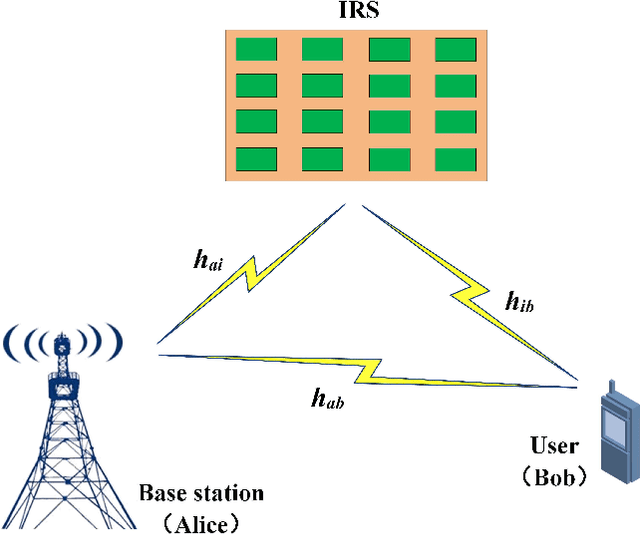
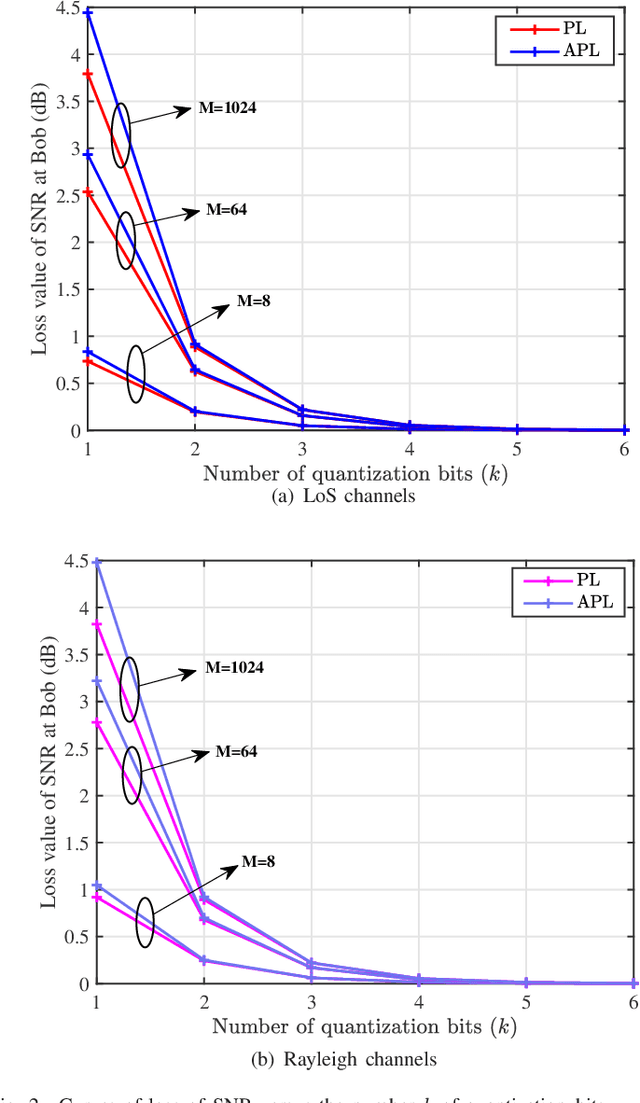
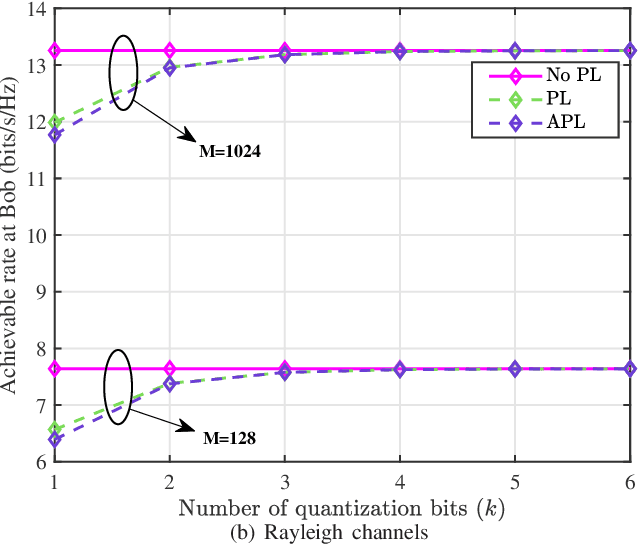
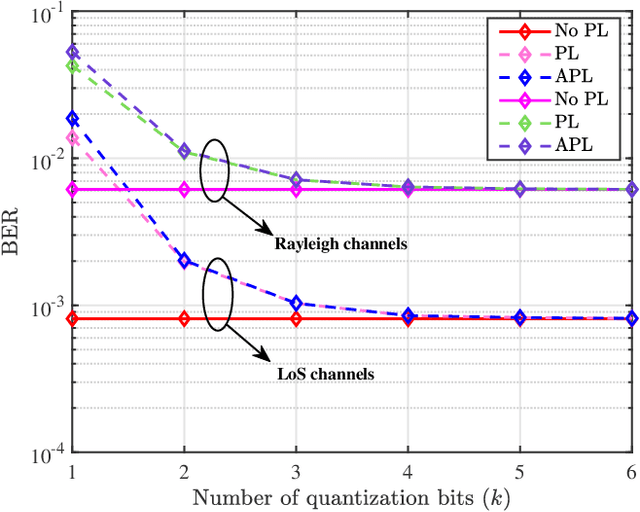
Abstract:Discrete phase shifters of intelligent reflecting surface (IRS) generates phase quantization error (QE) and degrades the receive performance at the receiver. To make an analysis of the performance loss caused by IRS with phase QE, based on the law of large numbers, the closed-form expressions of signal-to-noise ratio (SNR) performance loss (PL), achievable rate (AR), and bit error rate (BER) are successively derived under line-of-sight (LoS) channels and Rayleigh channels. Moreover, based on the Taylor series expansion, the approximate simple closed form of PL of IRS with approximate QE is also given. The simulation results show that the performance losses of SNR and AR decrease as the number of quantization bits increase, while they gradually increase with the number of IRS phase shifter elements increase. Regardless of LoS channels or Rayleigh channels, when the number of quantization bits is larger than or equal to 3, the performance losses of SNR and AR are less than 0.23dB and 0.08bits/s/Hz, respectively, and the BER performance degradation is trivial. In particular, the performance loss difference between IRS with QE and IRS with approximate QE is negligible when the number of quantization bits is not less than 2.
Machine-learning-aided Massive Hybrid Analog and Digital MIMO DOA Estimation for Future Wireless Networks
Jan 12, 2022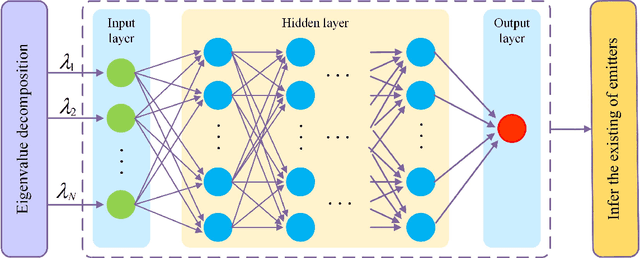
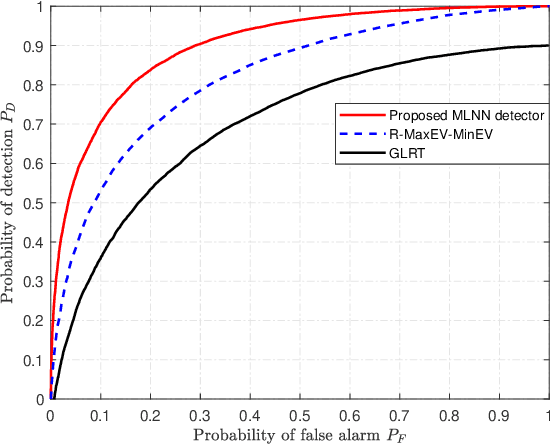
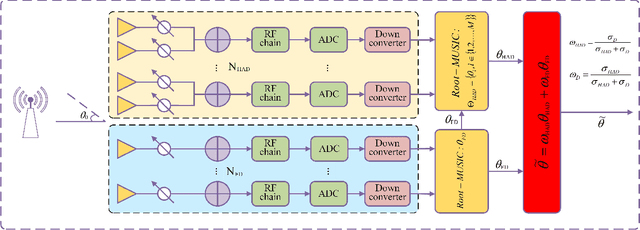
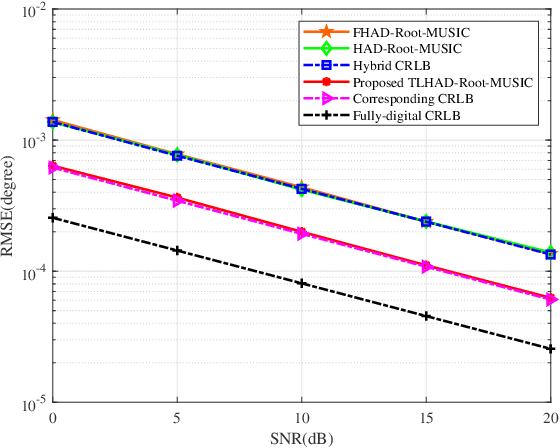
Abstract:Due to a high spatial angle resolution and low circuit cost of massive hybrid analog and digital (HAD) multiple-input multiple-output (MIMO), it is viewed as a key technology for future wireless networks. Combining a massive HAD-MIMO with direction of arrinal (DOA) will provide a high-precision even ultra-high-precision DOA measurement performance approaching the fully-digital (FD) MIMO. However, phase ambiguity is a challenge issue for a massive HAD-MIMO DOA estimation. In this paper, we review three aspects: detection, estimation, and Cramer-Rao lower bound (CRLB) with low-resolution ADCs at receiver. First, a multi-layer-neural-network (MLNN) detector is proposed to infer the existence of passive emitters. Then, a two-layer HAD (TLHAD) MIMO structure is proposed to eliminate phase ambiguity using only one-snapshot. Simulation results show that the proposed MLNN detector is much better than both the existing generalized likelihood ratio test (GRLT) and the ratio of maximum eigen-value (Max-EV) to minimum eigen-value (R-MaxEV-MinEV) in terms of detection probability. Additionally, the proposed TLHAD structure can achieve the corresponding CRLB using single snapshot.
Beamforming and Transmit Power Design for Intelligent Reconfigurable Surface-aided Secure Spatial Modulation
Jun 07, 2021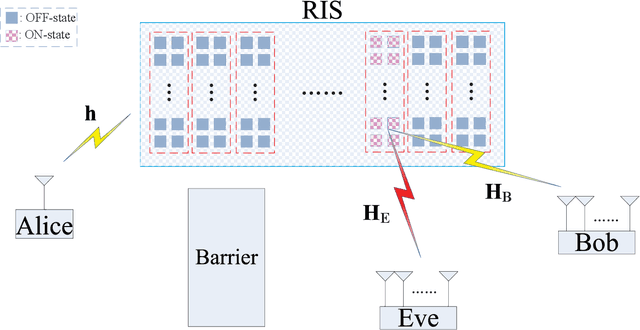
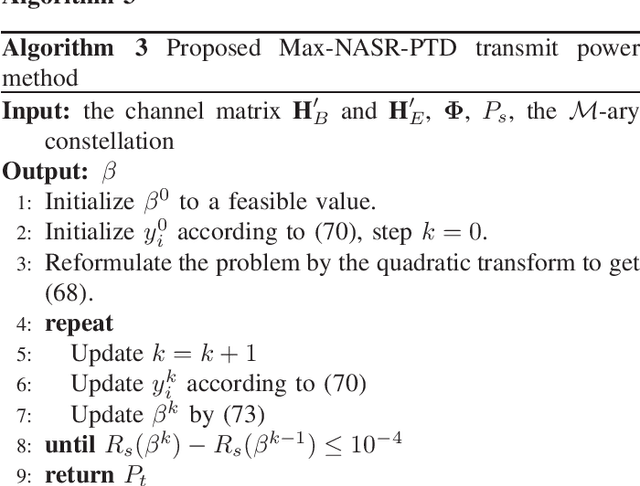
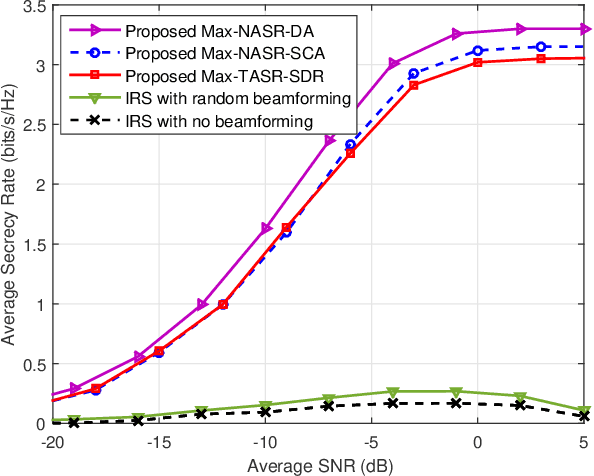
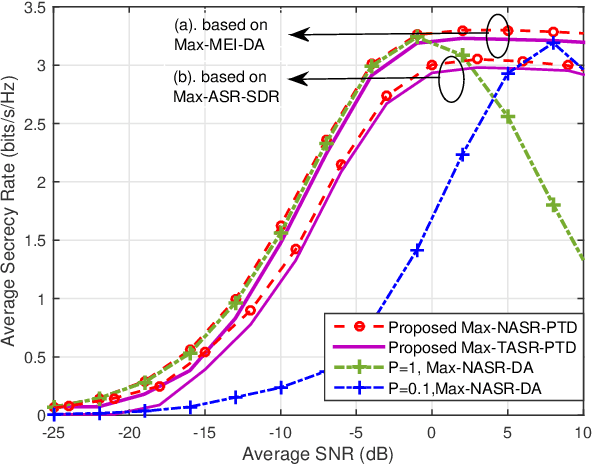
Abstract:Intelligent reflecting surface (IRS) is a promising solution to build a programmable wireless environment for future communication systems, in which the reflector elements steer the incident signal in fully customizable ways by passive beamforming. In this paper, an IRS-aided secure spatial modulation (SM) is proposed, where the IRS perform passive beamforming and information transfer simultaneously by adjusting the on-off states of the reflecting elements. We formulate an optimization problem to maximize the average secrecy rate (SR) by jointly optimizing the passive beamforming at IRS and the transmit power at transmitter under the consideration that the direct pathes channels from transmitter to receivers are obstructed by obstacles. As the expression of SR is complex, we derive a newly fitting expression (NASR) for the expression of traditional approximate SR (TASR), which has simpler closed-form and more convenient for subsequent optimization. Based on the above two fitting expressions, three beamforming methods, called maximizing NASR via successive convex approximation (Max-NASR-SCA), maximizing NASR via dual ascent (Max-NASR-DA) and maximizing TASR via semi-definite relaxation (Max-TASR-SDR) are proposed to improve the SR performance. Additionally, two transmit power design (TPD) methods are proposed based on the above two approximate SR expressions, called Max-NASR-TPD and Max-TASR-TPD. Simulation results show that the proposed Max-NASR-DA and Max-NASR-SCA IRS beamformers harvest substantial SR performance gains over Max-TASR-SDR. For TPD, the proposed Max-NASR-TPD performs better than Max-TASR-TPD. Particularly, the Max-NASR-TPD has a closed-form solution.
 Add to Chrome
Add to Chrome Add to Firefox
Add to Firefox Add to Edge
Add to Edge